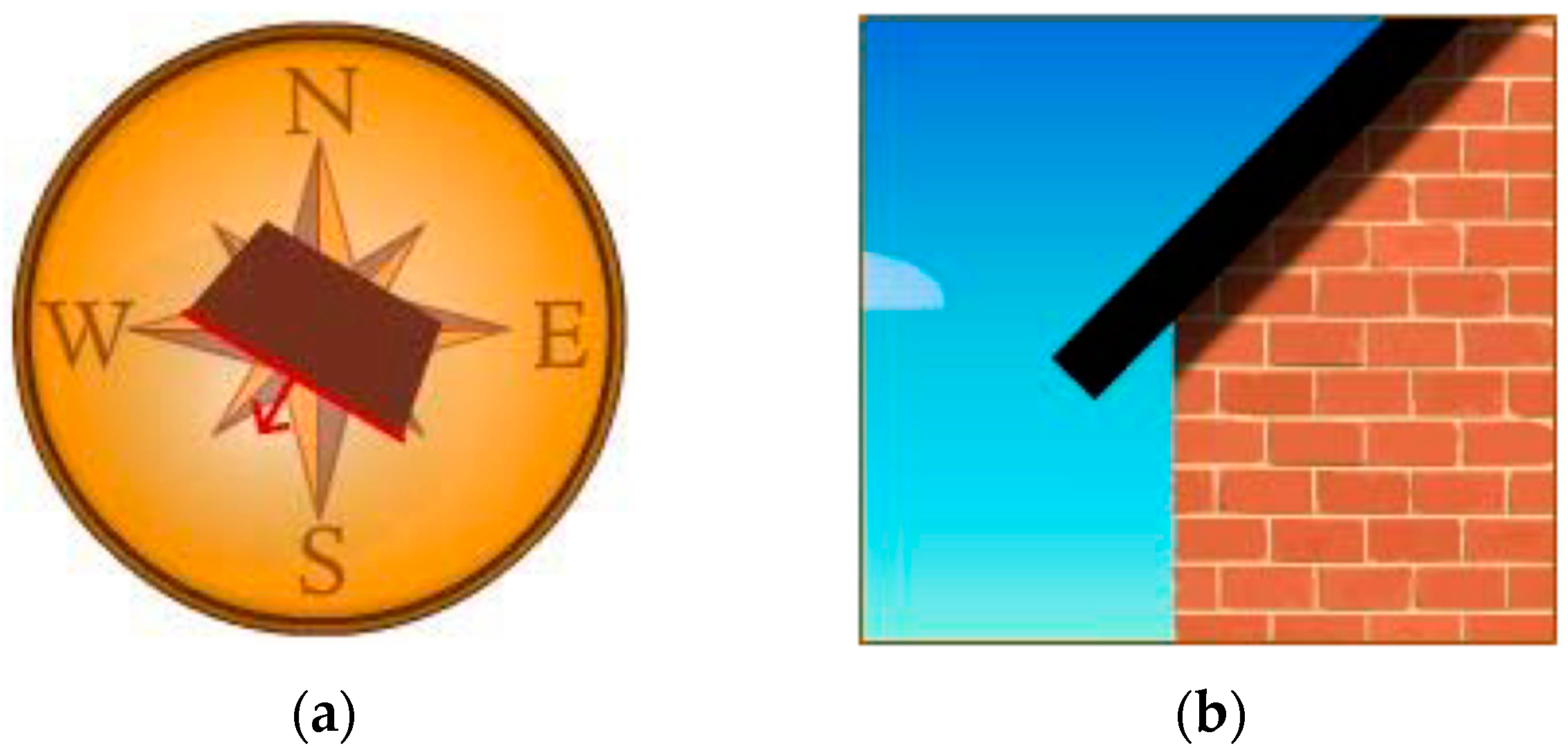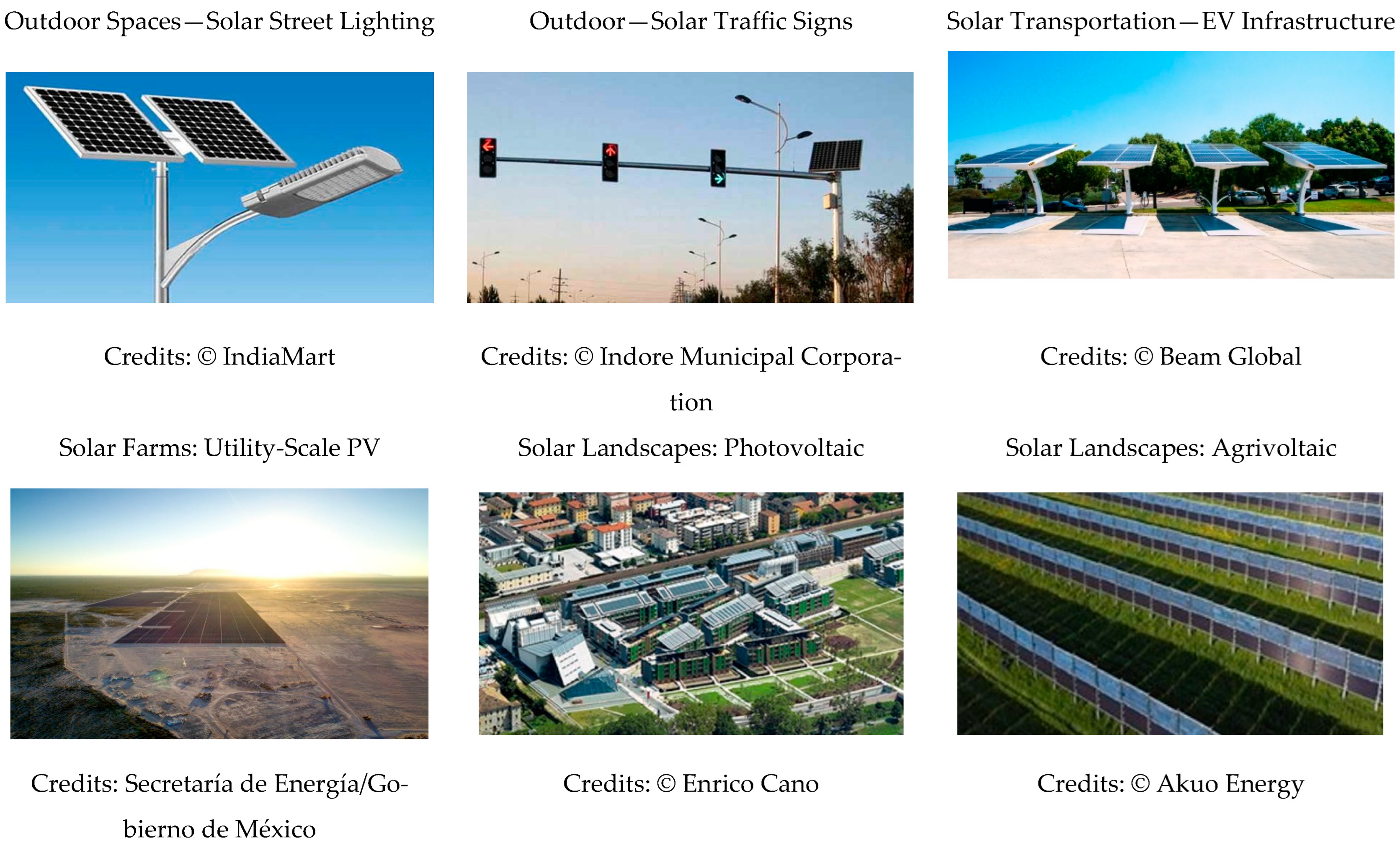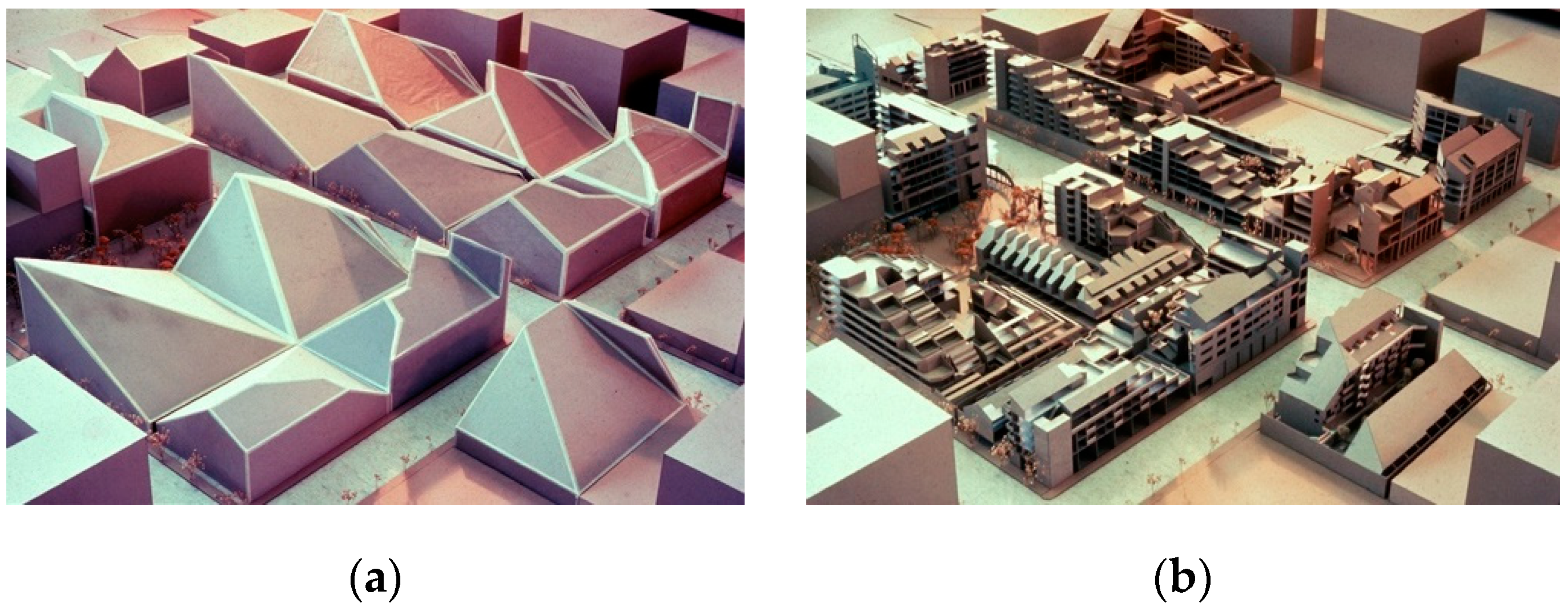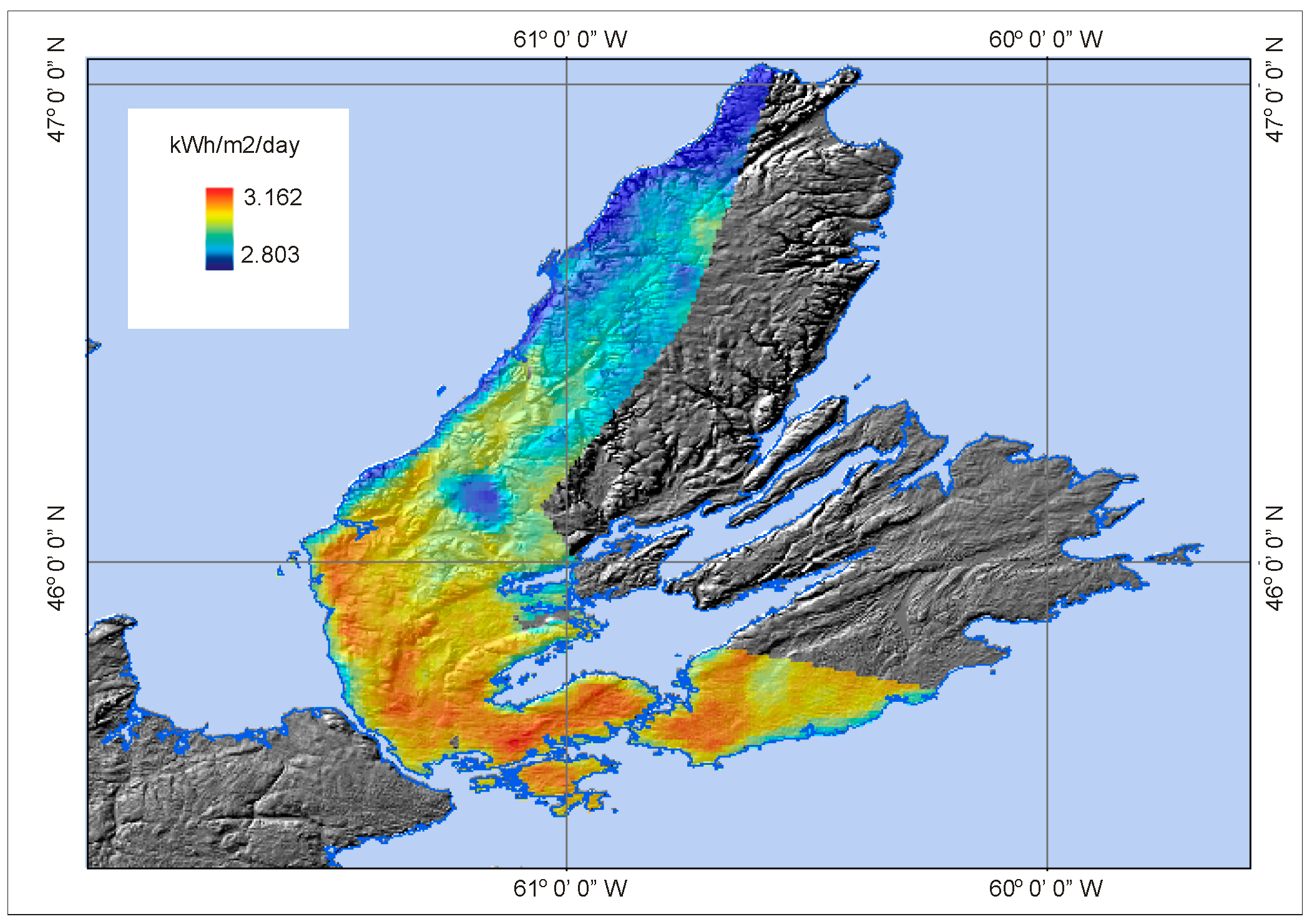Solar Architecture in Energy Engineering
Definition
1. Introduction
1.1. History
1.2. Solar Architecture Principles
- ➢
- Maximize solar energy harvesting on solution’s surfaces.
- ➢
- Maximize positive energy, carbon, and cost balance in solution’s life cycle.
1.3. Definitions
- Selecting and comparing solution options for energy resources;
- Choosing the best option in terms of energy resources, their use, cost, and carbon footprint; and
- Deploying and maintaining the use of the chosen energy resource mix.
- Selects and compares solution options for energy resources where renewable energy is a growing and preferably—a dominating resource in the energy mix; and
- Minimizes the use, cost, and carbon footprint of the energy mix.
- Selecting and comparing solution options for solar energy resources; and
- Deploying and maintaining the use of solar energy resources.
- Energy balance—the difference between solar energy harvested by the solution (the energy absorbed by the solution’s solar harvesting surfaces over its life cycle) and energy embedded in a solution;
- Carbon balance—the difference between carbon saved (the carbon dioxide not emitted by a solution or an environment the solution is a part of due to the solution’s operations during its life cycle) and carbon embedded in the solution; and
- Cost balance—the difference between the saved cost of energy (the cost that would be paid to a utility/energy service provider should the solution not use solar energy harvested by the solution in its operations over the life cycle) and the cost of the solution components and operations.
2. Methods and Applications
2.1. Solar Architecture Applications Methodology
2.1.1. Application Features
- -
- Spatial
- ○
- Land vs. water
- ○
- Urban vs. rural
- ○
- Highway (controlled-access/limited-access) vs. arterial/collector road vs. local road
- ○
- Onsite vs. remote
- -
- Temporal *
- ○
- Short-term (e.g., “minute, hour or day”) vs. mid-term (e.g., “month or year”) vs. long-term (e.g., multi-year) (* temporal category defines operational requirements in solar energy management)
- -
- Mobile
- ○
- Moving vs. stationary
- ○
- Civil vs. military
- -
- Transferable
- ○
- Active energy chain (harvesting (e.g., “solar power generation”)/transmission/distribution/storage/consumption) vs. passive energy chain (harvesting/storage/consumption)
- ○
- Grid-connected vs. near-grid vs. off-grid
- -
- Material
- ○
- PV: crystalline/thin-film/organic
- ○
- Construction: wood/stone/concrete/glass/metal/coating/asphalt shingle/sand/soil/plant
- ○
- Device: metal/semiconductor/plastic/liquid
- -
- Social
- ○
- Aesthetic
- ○
- Social impact
2.1.2. Application Groups
- Solar Buildings
- ○
- External envelope
- ▪
- Building-applied photovoltaics (BAPV)
- ▪
- Building-integrated photovoltaics (BIPV)
- ○
- Internal envelope
- ▪
- Organic PV energy harvesting
- ○
- Solar water heating
- ▪
- Domestic water heating
- ▪
- In-floor water heating
- Solar Outdoor Spaces
- ○
- Solar street lighting
- ○
- Solar campuses
- ○
- Solar parks
- ○
- Solar carports/canopies
- ○
- Solar parking ticket machines
- ○
- Solar digital advertising screens and billboards
- Solar Farms
- ○
- Utility scale
- ○
- Community solar
- ○
- Rooftop PV
- Solar Lanscapes
- ○
- Photovoltaic
- ○
- Agrivoltaic
- ○
- Landscape lighting
- Solar-Powered Vehicles
- ○
- Land vehicles (e.g., solar-powered EV) and infrastructure (e.g., solar charging EV stations, solar traffic signs, etc.)
- ○
- Marine vehicles (e.g., solar ferries) and infrastructure (e.g., solar buoys)
- ○
- Aerial vehicles (e.g., solar-powered planes) and infrastructure (e.g., solar runway and taxiway signs, terminals, etc.)
- ○
- Space vehicles (e.g., spacecraft such as communications, Earth observation, meteorology and navigation satellites, etc.) and infrastructure
2.1.3. Solar Architecture Table
2.2. Solar Harvesting Surface Methodologies
2.2.1. Energy Harvesting Surfaces—The Key to Solar Architecture
“The properties of an object’s surface absorbing sunlight…are not merely superficial; they construct the spatial effects by which solar architecture communicates. Through its surfaces an object declares both its autonomy and its ability to be energized”.
- Any surface in 3D space can be described by two spatial properties: tilt and azimuth.
- ○
- For linear surfaces (planes), tilt and azimuth of all the points on the surface is the same (Figure 3).
- ○
- For non-linear (curved) surfaces, the tilts and azimuths of points may be different.
- Every point on the surface has its specific geographic coordinates (e.g., latitude and longitude).
- Any surface has latitude and longitude ranges.

2.2.2. Solar Irradiation on Surfaces: Direct and Diffuse
2.2.3. Access to Energy Harvesting Data: Solar Resource Maps
2.3. Solar Energy Conversion and Losses Reduction Methodologies
2.3.1. Photovoltaic Conversion
2.3.2. Solar to Thermal Energy Conversion
2.3.3. Solar to Chemical Energy Conversion
2.4. Life Cycle Assessment Methodologies for Circular Economy
2.4.1. Life Cycle Energy Assessment
2.4.2. Life Cycle Carbon Assessment
2.4.3. Life Cycle Cost Assessment
3. Expected Results and Outcomes
3.1. Solar Architecture Ratios
- ▪
- Those using Solar Architecture Balance, and based on energy, carbon, and cost; and
- ▪
- Those using Solar Architecture categories such as life cycle use and energy harvesting, and based on sub-categories such as embodied, operating and waste energy, carbon, and cost.
- Energy-to-Carbon Ratio, kWh/kg CO2
- Energy Cost Ratio, kWh/$
- Carbon Cost Ratio, kg CO2/$
- Embodied-to-operating, embodied-to-waste, and operating-to-waste ratios; and
- Embodied-to-life cycle use, operating-to-life cycle use, and waste-to-life cycle use ratios within the life cycle use category.
- PV to Solar Thermal, PV to Solar Chemical, Solar Thermal to Solar Chemical; and
- PV to Energy Harvesting, Solar Thermal to Energy Harvesting, Solar Chemical to Energy Harvesting.
3.2. Solar Architecture Scorecards
3.3. Return on Investment as an Energy Engineering Driver
3.3.1. Energy Return on Investment
3.3.2. Carbon Return on Investment
3.3.3. Cost Return on Investment
3.4. Solar Architecture—Decision-Making
4. Conclusions
Funding
Institutional Review Board Statement
Informed Consent Statement
Acknowledgments
Conflicts of Interest
Appendix A. Solar Architecture Table Outputs
| Solution Features | GROUP: Solar Buildings—External Envelope | |
|---|---|---|
| CATEGORY: | Building-Applied Photovoltaics (BAPV) | Building-Integrated Photovoltaics (BIPV) |
| Spatial | ||
| urban | High-density built environment | High-density built environment |
| onsite | Roof surface segments | Wall surface segments |
| Temporal | ||
| short-term | Short-term (hourly) energy changes in PV power generation to maximize solar energy in the building energy mix. May need to optimize/reduce PV power generation to meet utility grid requirements. | Short-term (hourly) energy changes in PV power generation to maximize solar energy in the building energy mix. No limitations in solar power generation. |
| Mobile | ||
| stationary | Fixed-tilt mount | Fixed-tilt mount |
| civil | Commercial building | Commercial building |
| Transferable | ||
| Active energy chain: | ||
| solar generation | Active energy harvesting only through PV power generation | Active energy harvesting through PV power generation |
| storage | Batter-based electricity storage for PV and for utility time-of-use rates | |
| Passive energy chain: | ||
| harvesting | Passive energy harvesting for heating | |
| grid-connected | Front-of-the-meter (FTM), grid-interactive, may sell ancillary services to grid | |
| near-grid | Behind-the-meter, temporary connection to grid | |
| Material | ||
| PV: | ||
| crystalline | Monocrystalline silicon (c-Si) | |
| thin-film | Amorphous silicon (a-Si) | |
| organic | OPV | |
| Construction: | ||
| metal | Aluminium/V2A stainless steel mounting components | Aluminium/V2A stainless steel mounting components |
| glass | Heat-strengthened safety glass/PV glass | |
| Device: | ||
| metal | Aluminium (PV modules) Steel (balance-of system) | Aluminium (PV modules) Steel (balance-of system) Lithium (battery) |
| semiconductor | PV cell, inverter | PV cell, inverter, battery charger |
| plastic | Inverter (case), LED lights (cover) | |
| liquid | Batteries (electrolyte) | |
| Social | ||
| aesthetic | Provides aesthetic value to the building | |
| social impact | Contributes to building energy mix and provides economic value | Contributes to building energy mix and provides economic value |
References
- NASA. What Powers a Spacecraft. Available online: https://spaceplace.nasa.gov/what-powers-a-spacecraft/en/ (accessed on 31 July 2022).
- Wikipedia. Spacecraft. Available online: https://en.wikipedia.org/wiki/Spacecraft (accessed on 31 July 2022).
- Encyclopedia Britannica. Architecture. Available online: https://www.britannica.com/topic/architecture (accessed on 31 July 2022).
- PEI ARC Confederation Centre Arts Exhibit. Available online: https://www.cbc.ca/news/canada/prince-edward-island/pei-ark-confederation-centre-arts-exhibit-1.3805330 (accessed on 31 July 2022).
- Schittich, C. Solar Architecture: Strategies, Visions, Concepts; Birkhäuser Verlag: Basel, Switzerland, 2003. [Google Scholar]
- Reinberg, G.W. Solar Architecture; Labella, A., Ed.; Librìa Verlag: Melfi, Italy, 2004. [Google Scholar]
- Scognamiglio, A. ‘Photovoltaic landscapes’: Design and assessment. A critical review for a new transdisciplinary design vision. Renew. Sustain. Energy Rev. 2016, 55, 629–661. [Google Scholar] [CrossRef]
- Toledo, C.; Scognamiglio, A. Agrivoltaic systems design and assessment: A critical review, and a descriptive model towards a sustainable landscape vision (three-dimensional agrivoltaic patterns). Sustainability 2021, 13, 6871. [Google Scholar] [CrossRef]
- Wikipedia. Architecture. Available online: https://en.wikipedia.org/wiki/Architecture (accessed on 31 July 2022).
- Wikipedia. Systems Architecture. Available online: https://en.wikipedia.org/wiki/Systems_architecture (accessed on 31 July 2022).
- Wikipedia. Sustainable Architecture. Available online: https://en.wikipedia.org/wiki/Sustainable_architecture (accessed on 31 July 2022).
- Leatherbarrow, D.; Mostafavi, M. Surface Architecture; MIT Press: Cambridge, MA, USA, 2002; Available online: https://mitpress.mit.edu/books/surface-architecture (accessed on 31 July 2022).
- Knowles, R. Energy and Form: An Ecological Approach to Urban Growth; MIT Press: Cambridge, MA, USA, 1975. [Google Scholar]
- Knowles, R.; Berry, R. Solar Envelope Concepts: Moderate Density Building Applications. Final Report; University of Southern California, Los Angeles. School of Architecture: Los Angeles, CA, USA, 1980. [Google Scholar] [CrossRef]
- Knowles, R. Sun Rhythm Form; MIT Press: Cambridge, MA, USA, 1985. [Google Scholar]
- Knowles, R. The Solar Envelope: Its meaning for energy and buildings. Energy Build. 2003, 35, 15–25. [Google Scholar] [CrossRef]
- Kensek, K.; Knowles, R. Solar access zoning: Computer generation of the solar envelope. In Proceedings of the ACSA SW Regional Meeting, Albuquerque, NM, USA, 31 October 1997; University of New Mexico: Albuquerque, NM, USA. [Google Scholar]
- Wikipedia. Thermal Mass. Available online: https://en.wikipedia.org/wiki/Thermal_mass (accessed on 31 July 2022).
- Solar Radiation Basics. U.S. Department of Energy, Solar Energy Technologies Office. Available online: https://www.energy.gov/eere/solar/solar-radiation-basics (accessed on 31 July 2022).
- Sengupta, M.; Xie, Y.; Lopez, A.; Habte, A.; Maclaurin, G.; Shelby, J. The National Solar Radiation Data Base (NSRDB). Renew. Sustain. Energy Rev. 2018, 89, 51–60. [Google Scholar] [CrossRef]
- NREL. The National Solar Radiation Data Base. Available online: https://nsrdb.nrel.gov (accessed on 26 July 2022).
- ESRI. ArcGIS Web Application. Available online: https://fgp-pgf.maps.arcgis.com/apps/webappviewer/index.html (accessed on 28 June 2022).
- Global Solar Atlas. Available online: https://globalsolaratlas.info/map (accessed on 22 June 2022).
- Pavlovski, A.; Kostylev, V. Urban Solar Mapping in North America: Reshaping the Vision. PV Mag. 2010, 7. [Google Scholar]
- Pavlovski, A.; Crace, J.; Kostylev, V.; Fletcher, J. Solar Architecture and Energy Engineering. J. Green Build. 2010, 5, 32–40. [Google Scholar] [CrossRef]
- Liu, J.; Yao, Y.; Xiao, S.; Gu, X. Review of status developments of high-efficiency crystalline silicon solar cells. J. Phys. D Appl. Phys. 2018, 51, 123001. [Google Scholar] [CrossRef]
- Chantana, J.; Kawano, Y.; Nishimura, T.; Mavlonov, A.; Negami, T.; Minemoto, T. Formation of Native Inx (O,S)y Buffer through Surface Oxidation of Cu(In,Ga)(S,Se)2 Absorber for Significantly Enhanced Conversion Efficiency of Flexible and Cd-Free Solar Cell by All-Dry Process. Solar RRL 2022, 6, 2200250. [Google Scholar] [CrossRef]
- Chen, W.; Zhu, Y.; Xiu, J.; Chen, G.; Liang, H.; Liu, S.; Xue, H.; Birgersson, E.; Ho, J.W.; Qin, X.; et al. Monolithic perovskite/organic tandem solar cells with 23.6% efficiency enabled by reduced voltage losses and optimized interconnecting layer. Nat. Energy 2022, 7, 229–237. [Google Scholar] [CrossRef]
- Feng, J.; Zhai, Q.; Zhu, Q. Research on improving heat dissipation of monocrystalline silicon solar cells based on radiation cooling. Int. J. Energy Res. 2022, 46, 12160–12172. [Google Scholar] [CrossRef]
- Jadhav, S.; Venkatraj, V. Thermal losses in central receiver solar thermal power plant. 2018. IOP Conf. Ser. Mater. Sci. Eng. 2018, 377, 012008. [Google Scholar] [CrossRef]
- Eck, M.; Hirsch, T.; Feldhoff, J.F.; Kretschmann, D.; Dersch, J.; Gavilan-Morales, A.; Gonzalez-Martinez, L.; Bachelier, C.; Platzer, W.; Riffelmann, K.-J.; et al. Guidelines for CSP Yield Analysis–Optical Losses of Line Focusing Systems; Definitions, Sensitivity Analysis and Modeling Approaches. Energy Procedia 2014, 49, 1318–1327. [Google Scholar] [CrossRef]
- Cocco, D.; Migliari, L.; Serra, F. Influence of thermal energy losses on the yearly performance of medium size CSP plants. In Proceedings of the ECOS2015, Pau, France, 29 June–3 July 2015. [Google Scholar]
- Ho, C.K. Review of High-Temperature Particle Receivers for Concentrating Solar Power. Appl. Therm. Eng. 2016, 109, 958–969. [Google Scholar] [CrossRef]
- Ho, C.K.; Albrecht, K.J.; Yue, L.; Mills, B.; Sment, J.; Christian, J.; Carlson, M. Overview and Design Basis for the Gen 3 Particle Pilot Plant (G3P3). In Proceedings of the SoIarPACES, Daegu, Korea, 1–4 October 2019. [Google Scholar]
- SAgbo, N.; Okoroigwe, E.C. Analysis of Thermal Losses in the Flat-Plate Collector of a Thermosyphon Solar Water Heater. Res. J. Phys. 2007, 1, 35–41. [Google Scholar] [CrossRef]
- Nguyen, B.; Yoon, S.H.; Choi, J.H. Effect of working-fluid filling ratio and cooling-water flow rate on the performance of solar collector with closed-loop oscillating heat pipe. J. Mech. Sci. Technol. 2012, 26, 251–258. [Google Scholar] [CrossRef]
- Springer, D.; Matt, S.; Christine, B.; Elizabeth, W. Using Solar Hot Water to Address Piping Heat Losses in Multifamily Buildings. In Alliance for Residential Building Innovation; National Renewable Energy Lab. NREL: Golden, CO, USA, 2015. [Google Scholar]
- Sugiyama, M.; Fujii, K.; Nakamura, S. (Eds.) Solar to Chemical Energy Conversion: Theory and Application; Springer: Cham, Switzerland; Springer Nature: Berlin, Germany, 2016. [Google Scholar] [CrossRef]
- André, L.; Abanades, S. Recent Advances in Thermochemical Energy Storage via Solid–Gas Reversible Reactions at High Temperature. Energies 2020, 13, 5859. [Google Scholar] [CrossRef]
- Carrillo, A.J.; González-Aguilar, J.; Romero, M.; Coronado, J.M. Solar Energy on Demand: A Review on High Temperature Thermochemical Heat Storage Systems and Materials. Chem. Rev. 2019, 119, 4777–4816. [Google Scholar] [CrossRef]
- Falter, C.; Pitz-Paal, R. Energy analysis of solar thermochemical fuel production pathway with a focus on waste heat recuperation and vacuum generation. Sol. Energy 2018, 176, 230–240. [Google Scholar] [CrossRef]
- Foyer, C.H.; Ruban, A.V.; Nixon, P.J. Photosynthesis solutions to enhance productivity. Phil. Trans. R. Soc. 2017, 372, 20160374. [Google Scholar] [CrossRef]
- Circular Economy: Definition, Importance and Benefits. Available online: https://www.europarl.europa.eu/news/en/headlines/economy/20151201STO05603/circular-economy-definition-importance-and-benefits (accessed on 31 July 2022).
- ISO 14040:2003; Environmental Management—Life Cycle Assessment—Principles and Framework. Available online: https://www.iso.org/standard/37456.html (accessed on 31 July 2022).
- 13.020.60 Product life-Cycles Including Environmental Footprint, Carbon Neutrality. Available online: https://www.iso.org/ics/13.020.60/x/ (accessed on 31 July 2022).
- NREL Simple Levelized Cost of Energy (LCOE) Calculator Documentation. Available online: https://www.nrel.gov/analysis/tech-lcoe-documentation.html (accessed on 31 July 2022).
- Muteri, V.; Cellura, M.; Curto, D.; Franzitta, V.; Longo, S.; Mistretta, M.; Parisi, M.L. Review on Life Cycle Assessment of Solar Photovoltaic Panels. Energies 2020, 13, 252. [Google Scholar] [CrossRef]
- Lizin, S.; Van Passel, S.; De Schepper, E.; Maes, W.; Lutsen, L.; Manca, J.; Vanderzande, D. Life cycle analyses of organic photovoltaics: A review. Energy Environ. Sci. 2013, 6, 3136–3149. [Google Scholar] [CrossRef]
- Zieminska-Stolarska, A.; Pietrzak, M.; Zbiciński, I. Application of LCA to Determine Environmental Impact of Concentrated Photovoltaic Solar Panels—State-of-the-Art. Energies 2021, 14, 3143. [Google Scholar] [CrossRef]
- Ito, M.; Komoto, K.; Kurokawa, K. Life-cycle analyses of very-large scale PV systems using six types of PV modules. Current 2010, 10, S271–S273. [Google Scholar] [CrossRef]
- Milousi, M.; Souliotis, M.; Arampatzis, G.; Papaefthimiou, S. Evaluating the Environmental Performance of Solar Energy Systems Through a Combined Life Cycle Assessment and Cost Analysis. Sustainability 2019, 11, 2539. [Google Scholar] [CrossRef]
- Sánchez-Cruces, E.; Barrera-Calva, E.; Lavanderos, K.; González, F. Life Cycle Analysis (LCA) of Solar Selective Thin Films by Electrodeposition and by Sol-gel Techniques. Energy Procedia 2014, 57, 2812–2818. [Google Scholar] [CrossRef][Green Version]
- Islam, M.T.; Huda, N.; Abdullah, A.B.; Saidur, R. A comprehensive review of state-of-the-art concentrating solar power (CSP) technologies: Current status and research trends. Renew. Sustain. Energy Rev. 2018, 91, 987–1018. [Google Scholar] [CrossRef]
- Whitaker, M.B.; Heath, G.A.; Burkhardt, J.J., III; Turchi, C.S. Life Cycle Assessment of a Power Tower Concentrating Solar Plant and the Impacts of Key Design Alternatives. Environ. Sci. Technol. 2013, 47, 5896–5903. [Google Scholar] [CrossRef]
- Desideri, U. Comparative analysis of concentrating solar power and photovoltaic technologies: Technical and environmental evaluations. Appl. Energy 2013, 102, 765–784. [Google Scholar] [CrossRef]
- Gasa, G.; Lopez-Roman, A.; Prieto, C.; Cabeza, L.F. Life Cycle Assessment (LCA) of a Concentrating Solar Power (CSP) Plant in Tower Configuration with and without Thermal Energy Storage (TES). Sustainability 2021, 13, 3672. [Google Scholar] [CrossRef]
- Pelay, U.; Azzaro-Pantel, C.; Fan, Y.; Luo, L. Life cycle assessment of thermochemical energy storage integration concepts for a concentrating solar power plant. Environ. Prog. Sustain. Energy 2020, 39, e13388. Available online: https://www.ff10.1002/ep.13388ff.ffhal-02500983 (accessed on 31 July 2022). [CrossRef]
- Ubando, A.; Rivera, D.R.T.; Chen, W.H.; Culaba, A.B. A comprehensive review of life cycle assessment (LCA) of microalgal and lignocellulosic bioenergy products from thermochemical processes. Bioresour. Technol. 2019, 291, 121837. [Google Scholar] [CrossRef]
- Heath, G.; Ravikumar, D.; Ovaitt, S.; Walston, L.; Curtis, T.; Millstein, D.; Mirletz, H.; Hartmann, H.; McCall, J. Environmental and Circular Economy Implications of Solar Energy in a Decarbonized U.S. Grid; National Renewable Energy Laboratory: Golden, CO, USA, 2022. Available online: https://www.nrel.gov/docs/fy22osti/80818.pdf (accessed on 31 July 2022).
- Hall, C.A.; Lambert, J.G.; Balogh, S.B. EROI of different fuels and the implications for society. Energy Policy 2013, 64, 141–152. [Google Scholar] [CrossRef]
- Reich, N.H.; Alsema, E.A.; Van Sark, W.G.J.H.M.; Turkenburg, W.C.; Sinke, W.C. Greenhouse gas emissions associated with photovoltaic electricity from crystalline silicon modules under various energy supply options. Prog. Photovolt. Res. Appl. 2011, 19, 603–613. [Google Scholar] [CrossRef]
- Hsu, D.D.; O’Donoughue, P.; Fthenakis, V.; Heath, G.A.; Kim, H.C.; Sawyer, P.; Choi, J.; Turney, D.E. Life Cycle Greenhouse Gas Emissions of Crystalline Silicon Photovoltaic Electricity Generation. Systematic Review and Harmonization. J. Ind. Ecol. 2012, 16, S112–S135. [Google Scholar] [CrossRef]
- IEEE 1547-2003; IEEE Standard for Interconnecting Distributed Resources with Electric Power Systems. Available online: https://standards.ieee.org/ieee/1547/2287/ (accessed on 31 July 2022).
- IEEE 1547-2018; IEEE Standard for Interconnection and Interoperability of Distributed Energy Resources with Associated Electric Power Systems Interfaces. Available online: https://standards.ieee.org/ieee/1547/5915/ (accessed on 31 July 2022).
- Enayati, B.; Bravo, R.; Ropp, M.; Higginson, M.; Agüero, J.; Key, T.; Cleveland, F.; Siira, M.; Quint, R.; Vartanian, C.; et al. Impact of IEEE 1547 Standard on Smart Inverters and the Applications in Power Systems; Technical Report; IEEE PES Industry Technical Support Leadership Committee: Piscataway, NJ, USA, August 2020. Available online: https://www.nrel.gov/grid/ieee-standard-1547/assets/pdfs/smart-inverters-applications-in-power-systems.pdf (accessed on 31 July 2022).
- Zinaman, O.; Bowen, T.; Aznar, A.Y. An Overview of Behind-the-Meter Solar-Plus-Storage Regulatory Design; NREL: Golden, CO, USA, 2020. [Google Scholar]







| Application Features | Solar Buildings | Solar Outdoor Spaces | Solar Farms | Solar Landscapes | Solar-Powered Vehicles |
|---|---|---|---|---|---|
| Spatial |  |  |  |  |  |
| Temporal |  |  |  |  |  |
| Mobile |  |  |  |  |  |
| Transferable |  |  |  |  |  |
| Material |  |  |  |  |  |
| Social |  |  |  |  |  |
| Solar Architecture Scorecard | Period of Use, Years | Energy, kWh | Carbon, kg CO2 | Cost, $ |
|---|---|---|---|---|
| Life Cycle Use | ||||
| Components |  |  |  |  |
| Raw Material Extraction |  |  |  |  |
| Manufacturing and Processing |  |  |  |  |
| Transportation and Delivery |  |  |  |  |
| Usage and Retail |  |  |  |  |
| Waste Disposal |  |  |  |  |
| Total Life Cycle Use | ||||
| Energy Harvesting Yield | ||||
| Photovoltaic |  |  |  |  |
| Solar Thermal |  |  |  |  |
| Solar Chemical |  |  |  |  |
| Total Energy Harvesting Yield | ||||
| Solar Architecture Balance |
Publisher’s Note: MDPI stays neutral with regard to jurisdictional claims in published maps and institutional affiliations. |
© 2022 by the author. Licensee MDPI, Basel, Switzerland. This article is an open access article distributed under the terms and conditions of the Creative Commons Attribution (CC BY) license (https://creativecommons.org/licenses/by/4.0/).
Share and Cite
Pavlovski, A. Solar Architecture in Energy Engineering. Encyclopedia 2022, 2, 1432-1452. https://doi.org/10.3390/encyclopedia2030097
Pavlovski A. Solar Architecture in Energy Engineering. Encyclopedia. 2022; 2(3):1432-1452. https://doi.org/10.3390/encyclopedia2030097
Chicago/Turabian StylePavlovski, Alexandre. 2022. "Solar Architecture in Energy Engineering" Encyclopedia 2, no. 3: 1432-1452. https://doi.org/10.3390/encyclopedia2030097
APA StylePavlovski, A. (2022). Solar Architecture in Energy Engineering. Encyclopedia, 2(3), 1432-1452. https://doi.org/10.3390/encyclopedia2030097






